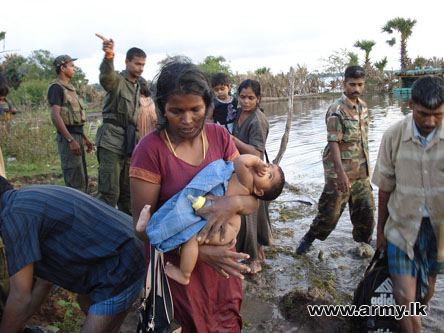Almost 200,000 Tamil civilians have fled the fighting between government forces and the Liberation Tigers of Tamil Eelam (LTTE), who have been fighting for an independent Tamil homeland for more than two decades.
More than half have crossed into government-controlled areas since 20 April.
The government wants to screen all entrants in a bid to separate non-combatant civilians from former LTTE fighters - a process to which the UN has only partial access, at Omanthai, the final screening point before Vavuniya.
“Expediting the screening and separation of former combatants from non-combatant civilians would permit a more rapid release of IDPs from the camps and would allow them to enjoy freedom of movement, including an option of staying with host families outside the camps,” Gordon Weiss, a spokesman for the UN, told IRIN in Colombo.
The separation of families continued to be a source of anxiety and distress for many people in the camps, Weiss said. “Reunification is a priority for families already split up, and every effort must be taken to avoid additional separations.”
According to the UN Office for the Coordination of Humanitarian Affairs (OCHA), almost 198,000 Tamil civilians are being accommodated in 41 camps in four districts, including Vavuniya, Jaffna, Mannar and Trincomalee, as of 13 May.
Many of the camps are overcrowded, with limited shelter, water and sanitation given the large numbers arriving, say aid workers.
Despite the efforts of the government, the military, and national and international aid agencies, minimum standards are not being met.
“The general health of the people in the camp remains extremely fragile,” Weiss said. “Conditions inside are not helping a population which has been under duress for such a long time.”
"The situation is still critical," Amin Awad, country representative of the UN Refugee Agency (UNHCR), added.
"We are coming to grips with it, but it is critical because of overcrowding in camps. People are lining up behind bulldozers as we clear the land [to set up shelters]," he explained.
The vast majority of the displaced - close to 180,000 - are at 25 such sites in Vavuniya.
"Overcrowding is creating a problem of hygiene, of shortages of water and medical care," Awad said.
Of particular concern are conditions at the Menik farm camp, the largest, just outside Vavuniya town. Spread over 400ha, the camp houses more than 120,000 IDPs.
Overcrowding, however, was also a concern at smaller transit sites in town, such as the Gamini Vidayala, a government primary school accommodating about 700 families.
|
Photo: Zelmira Sinclair/UNHCR  |
| Recent arrivals set up a tent at the camp at Menic Farm outside Vavuniya |
"[The] first [priority] is to get the shelters and we can work from there," Menaca Calyaneratne, a spokeswoman for Save the Children, told IRIN.
According to UNHCR, shelter requirements for new arrivals could be met, provided there was not a significant influx in the coming days.
"We are still clearing land, building the roads and the shelters," Awad confirmed.
“The needs of [IDPs], who have already suffered trauma and undergone extreme hardship, are enormous,” Weiss said.
On 13 May, Michele Montas, spokesperson for the UN Secretary-General in New York, said the UN continued to emphasise the need for the camps to be managed by civilians, and reiterated the need for more civilian police, including women police and police from the Tamil community.
As part of its response, the UN and the government of Sri Lanka announced on 5 May they are seeking US$50 million to address the urgent needs of up to 250,000 displaced persons over the next three months.
As of 13 May, the Common Humanitarian Action Plan remains just 32 percent-funded, making continued donor support critical.
contributor/ds/mw
This article was produced by IRIN News while it was part of the United Nations Office for the Coordination of Humanitarian Affairs. Please send queries on copyright or liability to the UN. For more information: https://shop.un.org/rights-permissions





